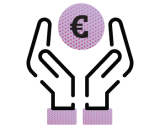Carefully investing your pension
hilips Pensioenfonds invests its assets in order to be able to pay the retirement incomes of the employees and former employees of Philips, Signify and Versuni. The pension premiums need to be invested in order to achieve an adequate retirement income. Investing involves risks, and Philips Pensioenfonds spends much of its time managing those risks as effectively and as efficiently as possible. Read more information below.
Active or passive portfolio management
Pension funds have two options to implement their investment strategy: active or passive management. With an actively managed portfolio, the manager attempts to outperform a ‘sample portfolio’, or benchmark. A passively invested portfolio only mimics this benchmark and does not attempt to outperform. While active management offers the possibility of higher returns than the benchmark, generally the costs of managing the portfolio will be significantly higher than the costs of passively managed portfolio. The lion’s share of Philips Pensioenfonds assets are therefore being managed passively. This is because the benefits of active management are generally not enough to justify the higher costs. We invest passively, except when there are good reasons to invest actively. Good reasons for active investing may be that passive is not possible or that we expect active management to yield more after costs. Currently, we invest passively in equities and almost passively in developed market government bonds, which together account for about half of the investment portfolio.
The choice to invest passively also means that we invest for a longer period in the companies in our investment portfolio, so that the turnover (buying and selling of investments) is low. It is therefore important for the Fund that these companies continue to perform well in the long term. For this, the Fund enters into a dialogue with companies in which we invest. See also our engagement policy for this.
No performance fee for our asset manager
As a rule of thumb, it is impossible to say whether or not it is advisable to include a performance fee in the asset manager’s contract. If the contract specifies a performance fee, however, it is vital to make sure that the arrangements are transparent and satisfy various conditions. At this time, Philips Pensioenfonds does not have a performance fee as part of the arrangements with its asset manager. The asset manager's contract is terminable daily.
Low investment costs (0.32%)
Philips Pensioenfonds pays its external asset manager a management fee that represents a fixed percentage of the assets under management in each asset class. Philips Pensioenfonds also pays the asset manager a fee for additional services, such as risk management and advisory services. Other investment costs include investment-related supervision, managerial and organisation costs. In 2023, the investment costs were 0.32% of the average invested assets, while transaction costs were 0.14%. Those costs are described in our annual report, together with an explanation how the investment costs relate to our investment returns. Besides the investment costs, Philips Pensioenfonds also incurs transaction costs due to the buying and selling of its investment securities. Just as the investment costs, those transaction costs are also subtracted from the final investment returns. This means that the 6.7% return that Philips Pensioenfonds recorded in 2023 is stated net of those transaction costs. Compared with other pension funds, Philips Pensioenfonds has a relatively low level investment costs. This is because Philips Pensioenfonds has preferably opted for passive management; another is that it barely invests in comparatively expensive asset classes such as hedge funds and private equity.
By comparing the transaction costs incurred with a 'model portfolio', the Fund can gain insight into the reasonableness of these costs. The annual report extensively reports on the investment costs and transaction costs incurred.
Biggest factor in the returns: strategic choices by the Board
The strategic investment policy is determined by the Board of Trustees. The strategic investment policy is based on long-term pension obligations. The Board’s strategic choices determine around 90% of the ultimate investment return, making them the single most important factor that determines investment returns.
No investments in complex investment products
Wherever possible, it is important to us to invest in simple and transparent products, such as equities and bonds. Philips Pensioenfonds does not invest in complex investment products.
Investments in relatively simple derivatives only
Philips Pensioenfonds has a policy with regards to investing in derivatives. Only investments in relatively simple derivatives are allowed. The contract with the asset manager describes under what conditions investments may be made in such derivatives. One of those conditions is that this is permitted only if ‘collateral’ is provided to protect Philips Pensioenfonds in the event that the counter party in the derivative transaction files for bankruptcy.
Monitoring by the Board
The strategic investment policy is determined by the Board of Trustees. In turn, the Executive Board is responsible for the implementation of the strategic investment policy. As a consequence, the Executive Board determines the policies that the asset manager needs to adhere to. This provides a framework within which the asset manager may make investment decisions on its own. The Pension Fund’s investments are spread across about twenty portfolios. Each portfolio has its own set of limitations that define how they must be operated. This is monitored by the Pension Fund Office of Philips Pensioenfonds, with the assistance of an independent third party that determines whether the asset manager’s decisions are compliant with the agreed investment terms. Philips Pensioenfonds knows in detail what products the asset manager selects for its investments on behalf of the Pension Fund.
Philips Pensioenfonds has included reporting rules in the agreement with the asset manager. These enable the Fund to determine whether the execution of the agreement leads to an investment portfolio that fits in with the long-term obligations. Legal rules apply to the asset manager's reports, such as the Long-Term Shareholder Involvement Directive (SRD II). Philips Pensioenfonds assesses whether the asset manager's reports comply with this.
Transparency and accountability
Philips Pensioenfonds feels strongly about the importance of transparency. We communicate openly and honestly about our policy and financial results. Policy decisions are being explained in as much detail as possible. But we also pay a lot of attention to the results and costs of those decisions. We communicate on a personal level, by sending our members letters and magazines. But we also share information by means of our annual report and on our website. Additionally, the Board of Trustees tries to engage with Philips Pensioenfonds’ beneficiaries through dialogue sessions that explain in greater detail important developments. The Pension Fund lists and describes all incurred costs in its annual report and on the website. In 2023, the investment costs were 0.32% of the assets invested. Costs concerning the pension administration were € 137 per member (not including holders of non-contributory policies).
We do not invest directly in Philips, Signify and Versuni
Philips Pensioenfonds does not invest directly in the affiliated companies Philips, Signify and Versuni. However, our investment portfolio also includes products where there is an 'indirect' investment. This means that we do not invest directly in a company, but for example in investment funds. When opting for these indirect investments, investments are avoided where possible that include Philips, Signify and Versuni.
Management of conflicts of interest in implementing investment policy
The Fund believes it is very important to properly manage risks associated with the execution of the investment policy. Our Verklaring beleggingsbeginselen (in Dutch) describes how this risk management is organized at the Fund. Our asset manager also has a code of conduct that describes how they put the interests of their clients first.
Related information
Is the information below perhaps also interesting for you?

Why does Philips Pensioenfonds make investments?
For the first part of the series about our investments the question 'Why does Philips Pensioenfonds make investments?' is answered.
Part 1
In which types of investments does Philips Pensioenfonds invest?
For the second part of the series about our investments the question 'In which types of investments does Philips Pensioenfonds invest?' is answered.
Part 2
How does Philips Pensioenfonds determine its investment mix?
For the third and last part of the series about our investments the question 'How does Philips Pensioenfonds determine its investment mix?' is answered.
Part 3